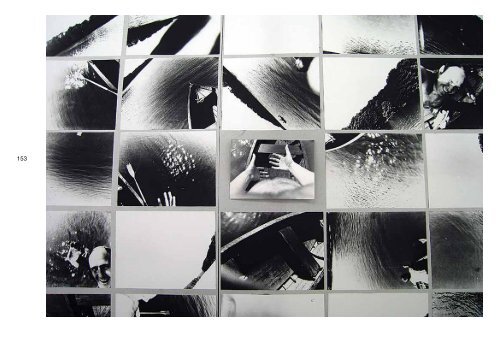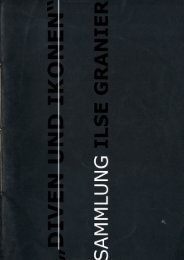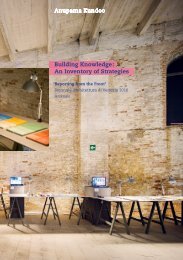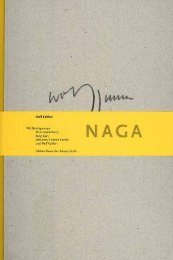Erfolgreiche ePaper selbst erstellen
Machen Sie aus Ihren PDF Publikationen ein blätterbares Flipbook mit unserer einzigartigen Google optimierten e-Paper Software.
»Augenblick, verweile doch ...«?<br />
Der Ausgangspunkt: Die Welt ist eine Illusion. Sie setzt sich zusammen aus<br />
den Gedanken, Gefühlen, Gewohnheiten des jeweiligen Betrachters. Und<br />
wie könnte eine Illusion von Bestand sein? Es lohnt nicht, etwas festhalten<br />
zu wollen. Jeder noch so schöne Augenblick vergeht, dito, glücklicherweise,<br />
auch jeder unangenehme. Ebenso verhält es sich mit unseren klugen<br />
Gedanken und bedeutenden Empfindungen. Ganz zu schweigen von dem<br />
Körper, mit dem wir uns so selbstverständlich identifizieren.<br />
Wer die Binsenweisheit von der Vergänglichkeit aller Erscheinungen einer<br />
ernsthaften Analyse unterzieht, könnte glatt auf die Idee kommen, dass es<br />
ein „Ich“ nicht gibt.<br />
Der Medienkünstler <strong>Wolf</strong> <strong>Kahlen</strong>, inspiriert vom tibetischen Buddhismus,<br />
verdeutlicht dies, indem er sich einer „rituellen Opferung“ unterwirft – im<br />
Internet, das die die Virtualität des Seins so schön veranschaulicht. Todesursache:<br />
Pixelabsorbtionskrankheit umschreibt er die in jeder Beziehung<br />
raffiniert getüftelte Arbeit Selbst-Los/Self-less www.wolf-kahlen.de. Wer<br />
den Links folgt und das jeweilige Bild, ein 35 Jahre altes Selbstporträt, ausdruckt<br />
bevor er weiterklickt, hält am Ende ein dreiteiliges, signiertes und<br />
nummeriertes Kunstwerk in Händen.<br />
Beim Öffnen des ersten Bildes verschwindet ein Pixel – zufallsgesteuert<br />
und mit hörbarem Sauggeräusch. Einen Mausklick weiter erscheint die<br />
Seite mit dem fortgeschlürfte Teilchen – einzeln, zusammenhanglos. Das<br />
Pixel fügt sich schließlich auf der dritten Seite in das ursprüngliche Bild,<br />
das sich nun negativ aufbaut – bis es vollständig ist und der ganze Prozess<br />
sich umkehrt: Pixel für Pixel, User für User, ein theoretisch endloses Stirb<br />
und Werde.<br />
Lange, bevor das Internet über uns kam und bevor <strong>Kahlen</strong> der buddhistischen<br />
Erkenntnisphilosophie begegnete, diente ihm Staub als Metapher<br />
für den Schein des Seins. Und als kunstvolles Mittel, Abwesendes wahrnehmbar<br />
zu machen. Elementarteilchen, Pixel oder Staub stehen für unsere<br />
bedingte Welt, der nicht zu trauen ist. So funktionieren die Arbeiten zum<br />
Thema „Staub auf Objekten“ als pointierte Überhöhungen. Ein weggenommener<br />
Gegenstande ist noch wahrnehmbar über die Staubschicht, die sich<br />
um ihn herum gebildet hat. Der Staub, selbst von alters her Sinnbild für<br />
den Verfall, übernimmt hier die Aufgabe, auf die Fragwürdigkeit eines<br />
anderen Objektes aufmerksam zu machen.<br />
Der Zweifel endet nicht bei den sichtbaren Phänomene. <strong>Kahlen</strong> arbeitet<br />
mit dem ganzen sinnlichen Spektrum. Beispielsweise mit der Sprache,<br />
die er zum Gegenstand seiner 365 Zeit-An-Sagen machte. Die eigentlichen<br />
Zeitaussagen sind, gefangen im Käfig der Vergänglichkeit. 365 Sprechstücke<br />
sehr unterschiedlicher Herkunft fügen sich zu einem künstlerischphilosophischen<br />
Hör-Kaleidoskop. Ein Doppelspiel wie auch im Falle der<br />
Staub-Arbeiten, denn was bleibt den Zeittexten anderes übrig, als im<br />
Zeitkontext abzulaufen. Und Zeit, so hören wir von dem tibetischen Arzt<br />
Shakya Dorje, ist nur eine Neurose, geboren aus der Angst vor dem Tod.<br />
Form ist Leerheit, Leerheit ist Form. Form und Leerheit: ungetrennt...<br />
Laut ist Leerheit, Leerheit ist Laut. Laut und Leerheit: ungetrennt...<br />
Freude ist Leerheit, Leerheit ist Freude. Freude und Leerheit: ungetrennt...<br />
Diese Kernsätze aus einem bekannten Dharma-Text, dem Herzsutra, sagen<br />
uns auch, dass <strong>Kahlen</strong>s Wahrnehmungs-Kunststücke keinesfalls nihilistisch<br />
sind. Denn die Leerheit als wahre Natur der Dinge ist die kreative Grundlage<br />
aller Wahrnehmungen. Die wir folglich nicht allzu ernst nehmen müssen.<br />
Das gilt für leidvolle Erlebnisse ebenso wie für freudvollen Kunstgenuss.<br />
Norbert Tefelski 2007<br />
154 155<br />
Evidence of time<br />
Conceived in different media over more than four decades the works of<br />
<strong>Wolf</strong> <strong>Kahlen</strong> are woven around certain main themes: the flow of time, perception,<br />
chance; leading motives: particles and fragmentary vision, transformation;<br />
and preferred materials: dust, light, the written word, sound and<br />
visual media. He himself has repeatedly mentioned the ungraspable notion<br />
of time as a main subject of his work. Texts about <strong>Kahlen</strong>’s artworks often<br />
refer to his influences from Buddhism. Still the artist’s practice seems as<br />
well to be pointing to the European tradition of transcendental philosophy –<br />
to the dialectic game between the ›common‹ and the ›essential‹, a priori<br />
conditions like space, change and duration and the multiplicity of subjective<br />
experiences and knowledge. <strong>Wolf</strong> <strong>Kahlen</strong> chooses associative ways<br />
for approaching this riddle – not so much experimenting and researching<br />
conditions of history and technology, but rather poetically revealing gaps<br />
within our perception.<br />
Attentive to the givens of time and nature, media artist <strong>Wolf</strong> <strong>Kahlen</strong> seems<br />
ironic towards promises of technology – photography, video and television –<br />
to provide the image of reality, to compress time or to substitute communication.<br />
›All photos are unreliable. Mine too.‹, to cite just one of <strong>Kahlen</strong>’s<br />
numerous writings on this subject. He seems to be questioning the relevance<br />
and reliability of the signs of culture and history in general: sending out<br />
preexposed photos (Photo Light Card – Exposed Since Travelling – Information<br />
revealed by development), gradually dismantling digital images into<br />
a monochrome field of pixels (on-line artworks Self-less and Cloud-less), or<br />
providing tools for chance-based reading of texts by national classics Perdone<br />
Don Cervantes, Sorry Mister Joyce, Verzeihung Herr von Goethe. The<br />
theme of the decline and reinvention of cultural signs is also exemplified<br />
by the installation A Cubic Meter of Intelligence – a cube of dust covered<br />
thrown-away books from East German libraries.<br />
For twenty years, since 1985, one of the main sites for <strong>Kahlen</strong>s activities<br />
has been the villa ›Ruine der Künste Berlin‹, left half-destroyed after WW II,<br />
which <strong>Wolf</strong> <strong>Kahlen</strong> restored as a space for ›material and immaterial arts‹ in<br />
context, and as a residency for international guest artists.<br />
Subversed technology, that is often giving in to the signs of time (like in<br />
Golden times – No matter of time), reminds not only of the Heideggerian<br />
break, but also of the iconography of a historic genre of painting : vanitas.<br />
Symbolising the brevity of life, still-lifes of the 17th century along other<br />
signs of decay picture mechanisms – watches and hourglasses. Another<br />
sign of transience and passing pleasures in these paintings are music<br />
instruments. The medium of sound as a time-marker or synchronising tool<br />
appears in <strong>Kahlen</strong>’s works since the mid 70’s. In the current exhibition the<br />
relations of sound, re-play, communication and interaction are represented<br />
by the 365 Zeit-An-Sagen – a sound work initially conceived for the ›Ruine<br />
der Künste Berlin‹ in 1988, when 365 sound sequences and texts on the<br />
subject of time provided by artists, scientist and para-psychologists were<br />
available throughout the whole year on the answering machine of the Ruine.<br />
The Automatics of the answering machine probably gives another hint for<br />
the understanding of <strong>Kahlen</strong>’s alignment of time and technology. Symptomatically<br />
for his generation, an interdisciplinary approach involves the<br />
association of systems in the natural and technological phenomena. Growth<br />
of dust, disintegration and the course of history appear to have automatic<br />
regularity and inevitability, while machinery becomes subject of dysfunction,<br />
entropy and change. However, human awareness, sometimes in a rather<br />
modernist sense embodied by the author himself, remains the main measure<br />
for these processes.<br />
Mara Traumane 2007








